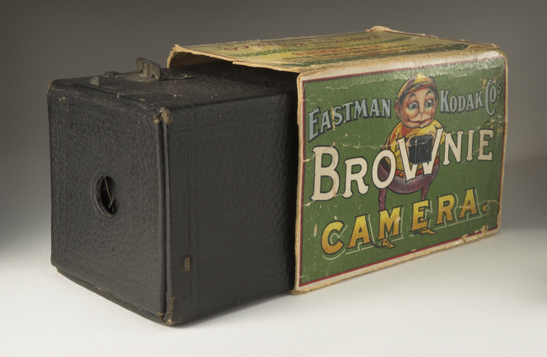Lecture Analysis
I remember when I was in middle school, I read this book called The Invention of Hugo Cabret by Brian Selznick, and it was based on this homeless boy getting in trouble with this shopkeeper. The shopkeeper’s name was different in the book, but basically he was one of the Lumiere Brothers and I kept thinking back to this book during the part of the lecture on cinematography. The book touches a little on the efforts that the Lumiere Brothers put into the creation of these films, and in all, I really admire how they used the technology they had in order to capture an entertaining experience.
Cinematography hasn’t been something I’ve put much effort into learning about. But I know that I appreciate when artists learn and perfect the trade they enjoy. Like so many others, my favourite film from their collection is Le Voyage Dans la Lun because it is whimsical and humorous. In my opinion, this is one of the films that best displays the pinnacle of their career.
Brownie Camera
>> The Brownie Camera is not a camera made out of brownies or weed, but a functional camera used by the general public in early 1900s and beyond to take pictures!

In the late 19th century, cameras had started to become a popular way for people to capture somber portraits of themselves and family members, rather than commissioning an artist to paint . The company, Eastman Kodak, was one of the headers in this operations and continued to put out new technology to replenish this new appetite. In 1898, Eastman Kodak had the idea of creating a camera that was accessible and affordable to all people, not just the wealthy middle/upper class.
It would be a special camera, not just used for portraits, but for anything people desired to take photos of.
This camera was, of course, the Brownie camera created by Kodak’s designer and manufacturer, Frank A. Brownwell. During the first year of production alone, this camera sold over 150, 000 cameras! This surpassed that of it’s predecessor, the Pocket Kodak which sold 3000 in the 6 years since it’s creation. In 1901, the Brownie No. 2 was released, which was a better improved version of the first. Sales began to rise as the demand got more desperate.
How they were made:
The box-shaped camera was first made with inexpensive materials, in order to make it affordable. The majority of the camera was made with jute board, which was typically a plyboard made from sulfate and pulp, and reinforced with wood. It also used a simple meniscus lens and took 2-inch square photos on 117 roll film. Some other physical attributes –
- covered with imitation leather
- rotary shutter
- overall mechanically uncomplicated
As stated before, these cameras were meant to be as straightforward as possible. Brownwell took this to his advantage and made it very cheaply, with as little gadgets as possible.
Marketing
The Brownie camera was the first in a series of simple, inexpensive cameras and introduced the idea of “snapshot” to the public.
 With that in mind, this camera was marketed primarily to children as something easy and fun to use.
With that in mind, this camera was marketed primarily to children as something easy and fun to use.
In comparison to the uptight photos taken of children during the mid 19th century, this was an activity that was appropriate for children. It also actively reflected their nature, as it allowed for quick, impromptu amusement and promoted creativity while playing. The years 1890-1920 is described by one writer as the “age of the child”. Much of commercial attention was on the value of child’s play and toys. So they had a true influence when it came to photography.

A Brownie at the seaside, 1905
Conclusion
The Brownie camera opened up the possibility for all people to be able to create using technology. This includes me today being able to complete class assignments with a camera and being able to afford it. It became less a privileged item to have, but rather an important tool people used to capture moments in time.
–
Works Cited
https://en.wikipedia.org/wiki/Brownie_(camera)
West, Nancy Martha. “Chapter 3: ‘Operated by Any School Boy or Girl’. (Cover Story).” Kodak & the Lens of Nostalgia, University of Virginia Press, 2000, pp. 74–108. EBSCOhost, ezproxy.capilanou.ca/login?url=https://search.ebscohost.com/login.aspx?direct=true&db=a9h&AN=24599131&site=eds-live&scope=site.